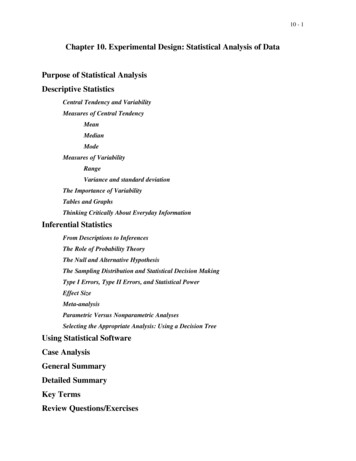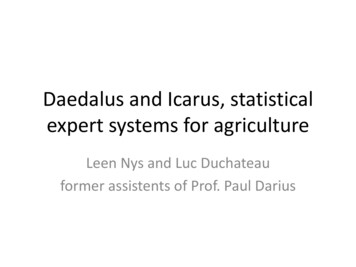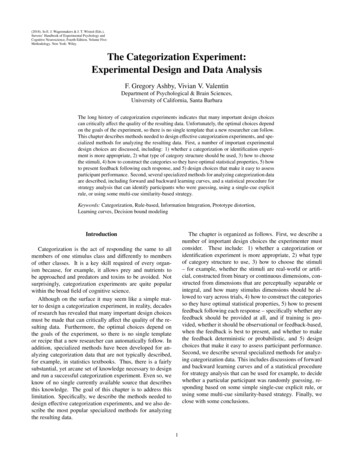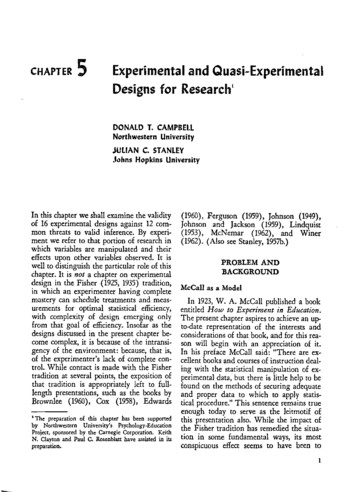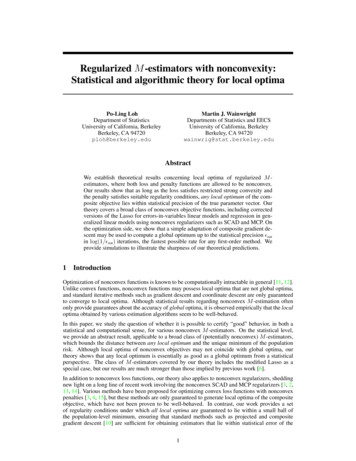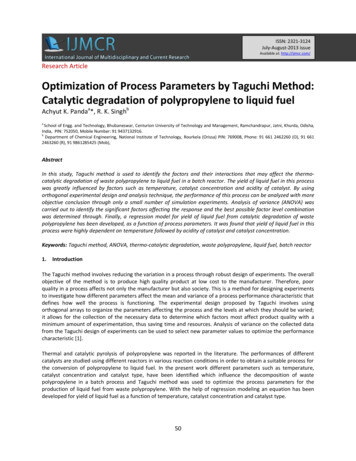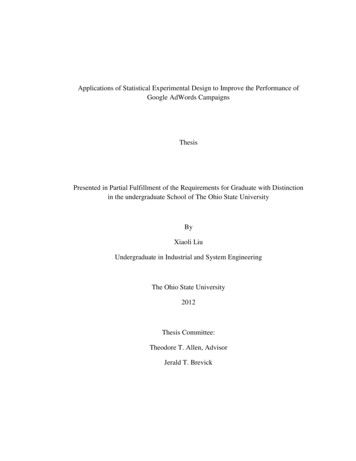
Transcription
Applications of Statistical Experimental Design to Improve the Performance ofGoogle AdWords CampaignsThesisPresented in Partial Fulfillment of the Requirements for Graduate with Distinctionin the undergraduate School of The Ohio State UniversityByXiaoli LiuUndergraduate in Industrial and System EngineeringThe Ohio State University2012Thesis Committee:Theodore T. Allen, AdvisorJerald T. Brevick
Copyright byXiaoli Liu2012i
AbstractGoogle AdWords are a set of self-advertising tools which are provided by GoogleCompany. Due to the complexity of the methods, the methods provide limitedinformation to users related to the many decisions associated with setting up an adcampaign including: daily budget, cost per click, the contents of the advertisement,and the key words selected. This thesis focuses on how to improve advertisementclick numbers with lowest cost using data to support decision-making. A case studyapplication of experimental design is included together with recommendations forfuture applications. The case study was based on a 12-run Plackett-Burman array. Inthe case study, we planned 12 individual varying 10 factors, and developed associatedstatistical data analysis. Results from the case study focus on so-called “covariates”and results indicate that the “day” affected the experiment result significantly as wellas both daily budget and cost per click had positive effects. Another issue that wasconsidered was the possible importance of “keywords”. The preliminary findingssuggest that “keywords” and the “day” or seasonality should be considered in futureexperiments and should be considered in future applications of statistical design ofexperiments.ii
VITA2004-2007 . The Second High SchoolAttached to Beijing NormalUniversity, Beijing, China2008-2012 .B.E., Integrated SystemsEngineering, The Ohio StateUniversity, Columbus, Ohioiii
Contents1.Introduction to Google AdWords . ii2.Facts and Problems . Error! Bookmark not defined.3. The Case Study Application of Experimental Design . vi3.1Method . vii3.2 Results and Analysis . viii4.Discussion. xiii5.Conclusions . xv6.References . iiiv
List of TablesTable 1. Factors and levels for the case study. . viiTable 2. The experimental design for the case study which is based on a 12 run PlacketBurman design. . viiiTable 3. Response data for the 12 campaigns. . ixv
List of FiguresFigure 1. A Text Advertisement Example. . iiFigure 2. A display of Google AdWords user dashboard for designing campaigns . iiiFigure 3. The keywords screen in the Adwords user page. . iiiFigure 4. Normal probability plot of standardized effects for the click responses indicating nosignificant effects. . xFigure 5. Main effects plot for the clicks response. . xiFigure 7. A Boxplot of the clicks for different days in the experiment. . xiivi
1. Introduction to Google AdWordsGoogle AdWords is Google’s main advertising product and source of revenue.Google’s total advertising revenues were 28,236 million in 2010 and 36,151million in 2011 (unaudited revenues). Three different advertising schemes aresupported by Google AdWords: pay-per-click (PPC), cost-per-thousand (CPM), andsite-targeted advertising for text, banner, and rich-media advertisements. Among thethree types, text advertisement is the probably the largest in revenues and the primaryfocus in this thesis. A primary feature of Google’s text advertisement is succinct: atext advertisement consists of one headline with 25 characters, two additional textlines with 35 characters each, and a URL line. Figure 1 illustrates a text advertisement.Furthermore, Figure 2 and 3 demonstrate a screen shot of Google AdWordsCampaigns page and keywords page.Figure 1. A Text Advertisement Example.ii
Figure 2. A display of Google AdWords user dashboard for designing campaignsFigure 3. The keywords screen in the AdWords user page.iii
In Google AdWords, a campaign indicates a set of advertisement groups whichincludes advertisements, keywords, and bids that share one daily budge, locationtargeting, and other settings. With one AdWords account, a user could have one ormore advertisement campaigns running. Also, some important responses in GoogleAdWords which are used to measure the performance of one advertisement includethe numbers of clicks or impressions and click through rate (CTR). A click is when auser interacts with one advertisement by clicking on it, typically showing an intentionto visit the advertised website; impression represents how often one advertisement isshown; click through rate represents the number of clicks that one advertisementreceives divided by the number of times this particular advertisement is shown. In ourcase study, the primary response is “clicks”. Impression and CTR are also consideredin the case study but not used as primary response measurements.2. Issues and ReviewUsers of Google AdWords have limited decision support information relevant to themany decision problems that they face. For example, it is not obvious how to set thecampaigns’ daily budget and cost per click, as well as picking the words within the anadvertisement accurately. Incomplete feedback indicates that the user is not able toreceive enough information to setup a suitable cost which includes daily budget andcost per click. Also, poor communication means that the potential advertisementiv
clickers may not be attracted by a shown advertisement because the descriptions andtitle are misleading or inaccurate.In fact, in setting up an advertising campaign even for a simple product like atextbook, there are potentially hundreds of decision problems. There are purchasingdecisions related to key words which when typed elicit the product. Further, there areoption in general related to where the advertisement will appear in Google searchresults, different world regions, in affiliates, and several other options.The literature related to supporting these decisions is small but growing. According toJoshi and Motwani’s (2006), there are two ways to identify new keywords which mayhave lower Cost-Per-Click but be equally effective: using relevant keywords andproximity-based tools. Relevant keywords increase the possibility for finding a betterdescription of one specific item. For example, if a customer searches “six sigma”, as arelevant keyword, “six sigma textbook” or “six sigma certification” may also show onthe screen so that the customer could choose a more accurate keywords which candescribe the need of customer in a better way. Proximity-based tools issue queries toa search engine to get highly ranked webpages for the seed keyword and expand theseed with words found in its proximity. For instance, when a customer searches“Hawaii Vacations”, a proximity-based tool could also give “Hawaii family vacations”or “Discount Hawaii Vacation” as an advance option. This keywords study provides abackground in analyzing data in next step. Moreover, it also could be applied in thisv
research for the next stage in which keywords will take place as a factor. Fuxman,Tsaparas, Achan, and Agrawal (2008) proposed a statistical approach based on the“wisdom of crowds” for supporting key word selection. The key idea explored here isto apply statistical experimental design to support decision-making about AdWordscampaign design. In Section 3, we describe a 3-day small, 12-run case studyapplication of experimental design focusing on the design of the actual text in theadvertisement and basic parameter. Then, the general implications for futureapplications of design of experiments methods are described in Section 4 andconclusions briefly reviewed in Section 5.3. The Case Study Application of Experimental DesignIn this section, we describe our case study application of experimental design whichfocuses on fostering a substantial improvement in the number of clicks and reductionin the cost per click. The application of experimental design for this purpose is,apparently, new and offers users of Google AdWords new types of decision supportto set up daily budget, cost per click, title, and description of advertisement quicklyand easily.vi
3.1MethodA 12-run Placett-Burman array is used as the DOE array since there are 10 factorsfrom four different categories in total with each independent variable has two levels.Table 1 shows the independent variables corresponding with two levels respect toindividual factor. Due to the limitation of characters of title line and description line,some factors are nested or the levels are dropped if spacing does not allow them. Theexperiments were released 4-at-a-time which was arbitrarily chosen for the initialexperimental design. Table 2 is a complete version of 12-run Plackett-Burman Array.Table 1. Factors and levels for the case study.vii
Table 2. The experimental design for the case study which is based on a 12 run Placket-Burman design.3.2 Results and AnalysisAfter ran the experiments from July 28, 2011 to August 12, 2011, a result matrix withresponses which includes clicks, impressions, CTR, average cost per click, cost, andaverage positions is given by Table 3. Notice that substantial variations are shown inall the responses.viii
Table 3. Response data for the 12 campaigns.With the aim of analyze the data, a normal probability plot of the standardized effects(Figure 4) is generated. However, there is no factor had a significant effect on anyresponse. As well, a Main Effects Plot for Clicks is also given as Figure 5. The noise level istoo high to make a conclusion. With the intention of making more precise analysis, it isindispensable to run the experiment mutiple times to gather more data. The only thing can behypothesized with some level of confidence is that daily budget affects clicks positively,which is which is the higher set daily budget, the more clicks it generates. This is obviousintuitively because when the budget is reached the advertisment stops being displayed so noix
clicks are possible. Additionally, a screen shot of results from Google AdWords application isshown as Figure 6.Figure 4. Normal probability plot of standardized effects for the click responses indicating no significant effects.x
Figure 5. Main effects plot for the clicks response.Figure 6. Summary data for the 12 campaigns in the case study.xi
We then explored analysis of the covariates including the “day” which was shown toplay an important role in this case study. It had significant affects from ANOVA.Figure 7 represents the relationship between Clicks and Day in a boxplot whereasFigure 8 represents the relationship between CTR and Day in a boxplot respectfully.In this special case, it is reasonable that people less likely to search a textbook duringweekends. However, if advertising other type of products (for example, a ski board),people may likely to search it without a date preference.Figure 7. A Boxplot of the clicks for different days in the experiment.xii
Figure 8. A box plot of the click through rate for the different days in the experiment.4. DiscussionIn our case study, we failed to find any significant effect for the factors varied. Yet,analysis of the covariates provided insights relevant to future experimentation. , Thereis no significant effect showed in this experiment besides the Day covariate despiterather large response ranges. One possibility is Title and descriptions are notimportant factors. Other responses can be considered.Yet, inspecting the case study results, offers some findings potentially relevant tofuture application of experimental design to web ad campaigns.1. It is important to spread campaigns over multiple days because the effect ofday in the week or years are likely larger than the advertisement contents.xiii
Moreover, a longer running time is needed in the next step research with thepurpose of analyzing the covariate day.2. Other factors besides clicks might be preferable for statistical reasons. In ourstudy, we found no significant factors but other responses such as clickthrough rate might be important and merit further investigation.3. The selection of key words via experimental design is likely important.Related factors relate directly to CTR, which means customers should typekeyword into the system and several ads show up, then customer decides clickwhich one. This means the current impendent variables only affect whetherthe customer click it or not after the true advertisement shows on the screen.Also, none of the factors affects whether the advertisement is selected to showon the screen but Keywords. Thus, it is necessary to add Keywords as anindependent variable as well as eliminate some not-so-important factors suchas specific description words.4. It is likely desirable to separate campaigns using different time periods and/ordifferent login identification. This is because when multiple ads run on thesame account Google provides automatic modulation of frequencies based onwhat is currently a hidden algorithm. With some ads being given negligibleimpressions as in Figure 4, results are somewhat suspect. Each uniqueexperiment should be run individually so that the competition with similaradvertisements would decrease.xiv
5. ConclusionsWe provided an application of design of experiments to the important new problem ofsetting up Google AdwWrds campaigns. Although the initial objects are not met inthe primary stage of research, an advanced research with appropriate changes of DOEarray could also make significant achievements in the future. This initial attemptpoints out a better direction to analyze Google AdWords. In the next stage, theresearcher will focus on different factors such as Keywords and experiments overmultiple days Day.xv
6. ReferencesAdWords. Wikipedia. http://en.wikipedia.org/wiki/AdWordsGoogle Adwords. Google (web). adwords.google.comFinancial Tables. Google Investor Relations. http://investor.google.com/fin data.html.Fuxman A, Tsaparas P, Achan K, and Agrawal R (2008). Using the wisdom of thecrowds for keyword generation. In WWW, pages 61–70.Joshi A, Motwani J (2006). Keyword generation for search engine advertising. InSixth IEEE International Conference on Data Mining Workshops, 2006. ICDMWorkshops 2006, pp. 490-496. Hong Kong, China: IEEE Computer Society.ii
campaign design. In Section 3, we describe a 3-day small, 12-run case study application of experimental design focusing on the design of the actual text in the advertisement and basic parameter. Then, the general implications for future applications of design


